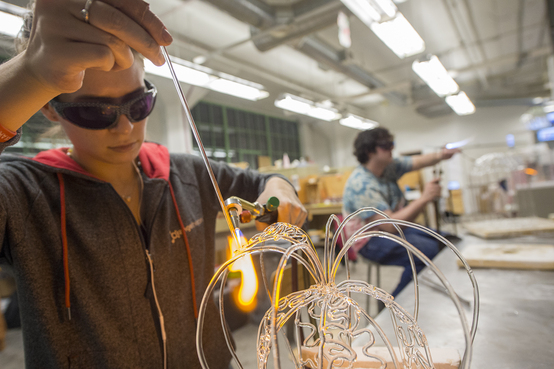
News . Feature Stories . Thinking Craft
News
April 10, 2018
Thinking Craft
New ideas meet at the corner of design and material arts

By Karen Sandstrom
The 21st century is a good time to be working in craft disciplines like ceramics, glass and metals. Not only do you inherit wisdom honed by makers over thousands of years, you get the benefits of digital-age technology.
The mixing of old and new is among the defining characteristics of contemporary craft, say Matthew Hollern and Seth Nagelberg. The faculty members in CIA Jewelry + Metals and Ceramics (respectively) share an interest in what the current era means for craft artists, and are among a group planning events for the college’s ThinkCraft Symposium in September.
What’s changing in the world of craft? For one thing, careers. “When we talk about all the career paths that students can pursue, entrepreneurship is probably the most frequent and the biggest assumption they make—that they're going to start a studio, make work, and start a business and sell that work,” Hollern says.
The classic studio to gallery model isn’t over, but CIA craft faculty want their students to consider a wider range of possibilities, including production work and design.
“There aren't as many students who say they want to be designers, but our students from China and Taiwan want to be designers, and they want to be business people,” Hollern says. “Four of them are planning to have a business together already. It's pretty exciting.”
Nagelberg says he likes to get students thinking of themselves as future entrepreneurs.
“I don't know if the gallery is the contemporary framework for them to work within,” he says. “‘Entrepreneur’ kind of covers a few more bases.”
The digital era gives emerging artists tools that can also make the business of art easier. Marketing, for instance, is faster and in many ways less expensive than it used to be.
On the other hand, simply having a website and Facebook page doesn’t guarantee success. “It doesn't get you entreé and connections with the people that real gallery directors can get you,” Hollern says. “It would be naive to think that you can just go out there and create your own career and represent yourself and get connected to all the people that you want. You can't. There are people who know people, and it's still a real thing.”
Technology is influencing the work itself, too. Hollern has been using computer-aided design (CAD) for 30 years, mixing traditional materials with the new. Last year, CIA acquired a 3D printer for ceramics; it is now one of seven 3D-output devices at the college.
Nagelberg has most recently used a CNC router for creating textures for a series of plates and bowls.
“My favorite is a mix of hand and digital work,” Nagelberg says, “going from a hand drawing to a computer to do a digital output like making a mold, and then resolving it by using my hands to press the clay into a mold and then do an assembly myself. To me, it’s really rich and it makes the work kind of confusing to look at.”
Hollern takes a slightly different approach. “The thing that I find really interesting about this moment is the idea of the hybrid, where you have established and traditional techniques and materials colliding with new materials and new techniques and technology all in one piece,” Hollern says.
Socially, the maker’s movement and DIY culture both intersect with craft, while heightened political sensibilities are fueling “craftivism” (cue the couple who knitted a replica of a Volkswagen van to make a point about transportation in Brazil).
In terms of craft education, the professors believe that some high schools are giving renewed attention to art programs, which have generally suffered in the era of the standardized test.
“The pendulum is swinging back a little bit,” Hollern says. “High schools are realizing that some of their students want a serious art program. Many of the private schools around Cleveland have really strong art programs. Laurel certainly does. Beaumont certainly does. And Cleveland Heights just built a new high school and has a very nice art department, and I know they have their own jewelry lab. Shaker Heights has a very nice art program. That is some serious teaching going on there, and the students are serious about their work.”
Nagelberg points out that this is part of a cultural shift toward making, and “reintroducing things like working with your hands again. It comes back either in craft and art, or in things like shop classes. I think there’s going to be a return, and it makes great sense to me.”
Latest Headlines view all
-
April 02, 2024
Cleveland Institute of Art students partner with Progressive Art Collection to exhibit Ready, Set, Relay! -
March 04, 2024
Cleveland Institute of Art announces Curlee Raven Holton Inclusion Scholar Program -
November 06, 2023
Collision of art and artificial intelligence creates murky waters for artists, curators and educators
Questions?
For more information about this or other CIA news, contact us here.
Social Feed